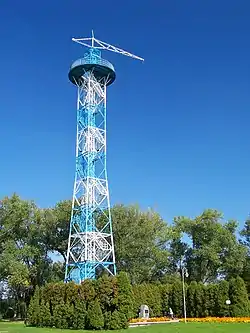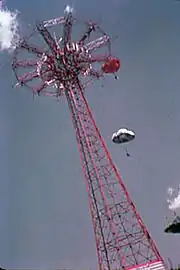Parachute tower
A parachute tower is a tower used for parachute training, often by members of a military paratroop unit. A mixture of tower heights are used at different stages of training. Trainees typically begin on towers around 35 feet (11 m) in height in fall-arrest harnesses before progressing onto parachute descents from towers that can be in excess of 250 feet (76 m). The use of towers allows trainees to practice their landing technique before jumping from an aircraft.

Use
Parachute towers are used to train people, particularly military paratroopers, in parachute jump technique. Towers are typically divided into low towers of approximately 35 feet (11 m) and high towers of around 100–200 feet (30–61 m) or higher. The shorter towers are used by trainees jumping in harnesses with a fall-restraint cable to simulate the exit from an aircraft and safe landing technique.[1]
Trainees then pass onto the high tower jumps with parachutes.[1] The high tower typically has one or more arms at the top from which the trainee is winched up into the air and released to descend by parachute.[2] The parachutes used are specific variants developed for training and were originally modified commercial systems, though the US military later developed the Type J-I parachute specifically for high tower jumps.[3]
The high tower allows trainees to practice the "body landing" (or parachute landing fall) technique, which is essential to avoid injuries such as broken legs or ankles.[2] The high tower can also be used to carry out "shock harness drills", intended to simulate the initial shock of a parachute canopy opening. The trainee is hauled up into the air and dropped to free fall approximately 15 feet (4.6 m) before being brought to a complete stop.[1] After high tower training is passed troops proceed onto aircraft jumps from an altitude of approximately 1,250 feet (380 m).[2][1] In the United States Army during the Second World War, five jumps from aircraft were sufficient to complete the course; the British Army required trainees to undertake an additional two jumps from tethered balloons prior to jumping from aircraft.[1]
Military history
.jpg.webp)
The first parachute tower in the United States was a 115-foot-tall (35 m) tower in Ocean County, New Jersey, built by Stanley Switlik and first used by Amelia Earhart on 2 June 1935.[4] The 262-foot (80 m) Parachute Jump ride at the 1939 New York World's Fair (later moved to Coney Island)[5] was a parachute tower, though the United States Army parachute training centre at Fort Benning had only 34-foot (10 m) towers until 1941.[6][3] Major William Lee of the United States Army, in charge of the training of the first 48-man platoon of US paratroopers, saw the Parachute Jump ride and constructed a similar tower at Fort Benning.[6] Three further towers were later erected. Each stood 254 feet (77 m) high and had four arms—each of which could hoist a single paratrooper—that spanned 134 feet (41 m).[2][3]
The Polish Army used the Parachute Tower Katowice for training. The tower was used as a vantage point on 4 September 1939 during the defence of the town from the German invasion. The story of its defence by Polish boy and girl scouts has been described as a "heroic myth".[7] Some of the Polish Army escaped to the United Kingdom after the fall of Poland and was based at Largo House, Scotland.[8] Here they constructed a parachute tower, the first to be built in the British Empire, which was used to train the 1st Independent Parachute Brigade.[8][9] The British military later constructed their own parachute tower (with capacity for two paratroopers) at RAF Ringway, which was moved to RAF Abingdon in 1950.[10][11]
The USSR had a large number of parachute training towers, with 559 in operation by 1939.[12] Japan had at least four in operation during the Second World War.[13] The Turkish Aeronautical Association constructed two parachute towers in İzmir and Ankara between 1935 and 1937 based on a Russian tower in use at Gorky Park.[14][15] Rhodesia also had a parachute tower at New Sarum Air Force Base.[16]
Fairground rides

As well as the original Parachute Jump at the 1939 World's Fair, there have been several other fairground rides based on a similar premise. The Pair-O-Chutes ride operated at Chicago's Riverview Park but was demolished in 1968.[17] Parachute towers, known as "Parachute Drops" were developed by Intamin for the Six Flags theme parks.[18][19] The Texas Chute Out operated at Six Flags Over Texas from 1976 to 2012; Great Gasp operated at Six Flags Over Georgia from 1976 to 2005 and Sky Chuter was at Six Flags Over Mid-America from 1978 to 1982.[19][20] Sky Chuter was relocated to Six Flags Great Adventure, where it reopened in 1983 as Parachuter's Perch, and as of 2019, it is still operational under the name "Parachute Training Center".[21][22][23] Intamin also produced a "Parachute Drop" for Knott's Berry Farm in California in the late 1970s, which was named "Sky Jump".[24][25] The parachute jump portion of the tower was removed but its observation tower remains in operation.[24] Tokyo Dome City Attractions, Japan, has an Intamin parachute drop ride named Sky Flower.[26]
References
- Horn, Bernd; Wyczynski, Michel (2002). Tip of the Spear: An Intimate Account of 1 Canadian Parachute Battalion, 1942–1945: a pictorial history (Print.). Toronto Ontario: Dundurn Press. p. 44. ISBN 9781459712829.
- Giallourakis, Bill (2019). Service in Combat, Court, and Home. Page Publishing Inc. p. 91. ISBN 9781644245262.
- Sweeting, C. G. (2015). United States Army Aviators' Equipment, 1917-1945. McFarland. p. 159. ISBN 9781476619460.
- "Amelia Earhart Uses Her First Parachute; Flier Makes Her Initial Jump, With a New Device From a 115-Foot Tower". The New York Times. 3 June 1935. Retrieved 26 October 2019.
- "Coney Island Dolls Up, Winks at Service Men". Brooklyn Daily Eagle. 30 May 1941. p. 7. Retrieved 18 July 2019 – via Brooklyn Public Library; newspapers.com

- Hagerman, Bart (1999). Seventeenth Airborne Division. Turner Publishing Company. p. 13. ISBN 9781563114366. Retrieved 25 October 2019.
- Moorhouse, Roger (2019). First to Fight: The Polish War 1939. Random House. p. 99. ISBN 9781473548220.
- Dialogue and Universalism. Warsaw University, Centre of Universalism. 2004. p. 93.
- Peszke, Michael Alfred (1995). Battle for Warsaw, 1939–1944. East European Monographs. p. 80. ISBN 9780880333245.
- "RAF Ringway (near Manchester). Parachute training tower: double dropping machine". National Archives. 1945. Retrieved 25 October 2019.
- Action Stations: Military airfields of the Cotswolds and the Central Midlands. Stephens. 1990. p. 265. ISBN 9781852603724.
- Zim, Herbert Spencer (1942). Parachutes. Harcourt, Brace and Company. p. 134.
- Attack, United States Congress Joint Committee on the Investigation of the Pearl Harbor (1946). Pearl Harbor Attack: Hearings Before the Joint Committee on the Investigation of the Pearl Harbor Attack, Congress of the United States, Seventy-ninth Congress, First [-second] Session, Pursuant to S. Con. Res. 27 ... U.S. Government Printing Office. p. 616.
- "Badge, Parachute Tower, Turkish Air Force". National Air and Space Museum. 14 March 2016. Retrieved 25 October 2019.
- "Türkiye'deki İkiz Paraşüt Kuleleri". Sanal Alfabe. Archived from the original on 26 September 2018. Retrieved 25 October 2019.
- Defence, Rhodesia and Nyasaland Ministry of (1962). Report of the Secretary for Defence and the Chief of General Staff and the Chief of Air Staff. p. 14.
- Vita, Tricia (January 30, 2004). "Thrill of a Lifetime". National Trust for Historic Preservation. Archived from the original on February 11, 2007. Retrieved July 18, 2019.
- Diamond, Randy (June 14, 1983). "This jump heads for oblivion". New York Daily News. p. 97. Retrieved July 18, 2019 – via newspapers.com

- "A Pair of Popular Six Flags Over Texas Rides Are Going Away". Six Flags Over Texa. August 2, 2012. Archived from the original on October 24, 2012. Retrieved August 2, 2012.
- Telthorst, Ann; Kelly, Robert (July 27, 1978). "Sky Ride's Fatal Fall Under Inquiry". St. Louis Post-Dispatch. Retrieved July 19, 2019 – via Missouri Historical Society; newspapers.com

- Applegate, Harry (2016). Six Flags Great Adventure. Images of Modern America. Arcadia Publishing Inc. p. 107. ISBN 978-1-4396-5613-6. OCLC 968096863. Retrieved July 19, 2019.
- "Parachuter's Perch At Six Flags Great Adventure". Great Adventure History. May 15, 1989. Archived from the original on March 21, 2019. Retrieved July 19, 2019.
- "Harry's Corner: Parachute Training Center". Six Flags Great Adventure & Safari. Archived from the original on July 19, 2019. Retrieved July 19, 2019.
- Daniels, Serena Maria (August 5, 2008). "Knott's Sky Cabin still closed after riders got stuck". Orange County Register. Archived from the original on July 19, 2019. Retrieved July 19, 2019.
- Jennings, Jay (2009). Knott's Berry Farm: The Early Years. Images of America. Arcadia Publishing. p. 122. ISBN 978-0-7385-6921-5. OCLC 320804621. Retrieved July 19, 2019.
- Mansfield, Stephen (2013). Top 10 Tokyo. Eyewitness Top 10 Travel Guides. DK Publishing. p. 130. ISBN 978-1-4654-0614-9. Retrieved July 20, 2019.
External links
